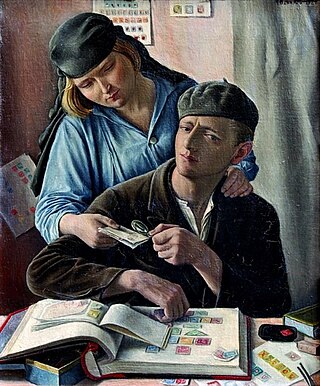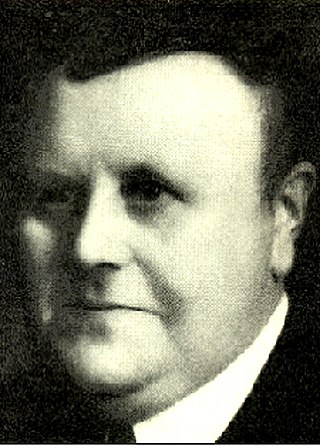
Stamp collecting is the collecting of postage stamps and related objects. It is an area of philately, which is the study of stamps. It has been one of the world's most popular hobbies since the late nineteenth century with the rapid growth of the postal service, as a stream of new stamps was produced by countries that sought to advertise their distinctiveness through their stamps.

The Inverted Jenny is a 24 cent United States postage stamp first issued on May 10, 1918, in which the image of the Curtiss JN-4 airplane in the center of the design is printed upside-down; it is one of the most famous errors in American philately. Only one pane of 100 of the invert stamps was ever found, making this error one of the most prized in philately.

Philip Ferrari de La Renotière was a noted French-born stamp collector, assembling probably the most complete worldwide collection that ever existed, or is considered likely to exist. Among his extremely rare stamps were the unique Treskilling Yellow of Sweden and the 1856 one-cent "Black on Magenta" of British Guiana.

The Treskilling Yellow, or three schilling banco error of color, is a Swedish postage stamp of which only one example is known to exist. This stamp was cancelled at Nya Kopparberget, about 150 kilometres (93 mi) from Uppsala, on July 13, 1857. It was last sold in 2010. The auction house valued the stamp between £1.29 million and £1.73 million before the sale. The winning bid was kept confidential.

The Inverted Swan, a 4-pence blue postage stamp issued in 1855 by Western Australia, was one of the world's first invert errors. Technically, it is the frame that is inverted, not the image of the swan, but it has become commonly known as the Inverted Swan.

The Red Mercury—Zinnoberrote Merkur, lit. "vermilion Mercury"—is the rarest of Austrian newspaper stamps. It was issued for the mailing of newspapers in Austria and Lombardy-Venetia.

The 2¢ Large Queen on laid paper is the rarest postage stamp of Canada. Printed in 1868, it was not discovered until 1925, and so far only three have been found, all used. Many more could exist as at least one sheet must have been printed, and possibly many sheets; however, they may all have been destroyed, or lie unrecognised in stamp collections or on cover.

The British Guiana 1c magenta is regarded by many philatelists as the world's most famous rare stamp. It was issued in limited numbers in British Guiana in 1856, and only one specimen is now known to exist. It is the only major postage stamp ever issued in the United Kingdom or British Commonwealth that is not represented in Britain's Royal Philatelic Collection.

The Mauritius "Post Office" stamps were issued by the British Colony Mauritius in September 1847, in two denominations: an orange-red one penny (1d) and a deep blue two pence (2d). Their name comes from the wording on the stamps reading "Post Office", which was soon changed in the next issue to "Post Paid". They are among the rarest postage stamps in the world.

The Hawaiian Missionaries are the first postage stamps of the Kingdom of Hawaii, issued in 1851. They came to be known as the "Missionaries" because they were primarily found on the correspondence of missionaries working in the Hawaiian Islands. Only a handful of these stamps have survived to the present day, and so they are amongst the great rarities of philately.

The Rare 2d Coil was an experimental vertical coil stamp, denominated 2d, issued by the Irish Post Office in 1935 and is one of the scarcest, and most valuable, Irish stamps. It is often referred to by stamp collectors simply as "Scott 68b" or "SG 74b", being the Scott and Stanley Gibbons stamp catalogue numbers respectively.

David Feldman MA. BBS, RDP(I).FRPSL is a professional philatelist, auctioneer, art specialist and author. He held his first stamp auction in 1967. Feldman is Honorary Chairman of David Feldman SA, a Geneva-based auction company, through which he attained record prices for some of the world's most famous postage stamps. In 1993, Feldman auctioned the "Bordeaux Cover", which comprised the 1847 1d Orange-red and the 2d Deep Blue Mauritius "Post Office" stamps, which brought 6,175,000 Swiss francs including all commissions, at that time the highest price ever paid for any philatelic item. He also sold the unique 1855 Sweden Treskilling Yellow stamp at auction in 1996, which at the time was the highest price ever paid for a single stamp, for which he was pictured in the Guinness Book of Records. That record was eclipsed in 2014 by the sale of the British Guiana 1c magenta.
Postage stamps and postal history of Baden refers to the postal history and postage stamps of the German state of Baden from 1851 to 1871.

Arthur Hind (1856–1933), of Utica, New York, was a British-born American textile industrialist and philatelist.

The British Library Philatelic Collections is the national philatelic collection of the United Kingdom with over 8 million items from around the world. It was established in 1891 as part of the British Museum Library, later to become the British Library, with the collection of Thomas Tapling. In addition to bequests and continuing donations, the library received consistent deposits by the Crown Agency and has become a primary research collection for British Empire and international history. The collections contain a wide range of artefacts in addition to postage stamps, from newspaper stamps to a press used to print the first British postage stamps.

Maurice Jean Marie Burrus was an Alsatian tobacco magnate, politician and philatelist. Originally from Alsace but residing in Switzerland, he was a deputy in the French parliament during the 1930s. His stamp collection was considered one of the greatest ever assembled and included some of the world's rarest stamps.

Canada 12d black or The Black Empress of Canada is the rarest Canadian postage stamp, issued in 1851. The 12-pence stamp shows the portrait of Queen Victoria and is the third stamp issued by the province.

The Penny Penates is a postcard that was posted on 14 July 1840 to Fulham in London. It was addressed to the writer and practical joker Theodore Hook, who was probably also its sender and artist. The hand-painted design on the postcard shows an image of post office clerks sitting around a giant ink well.


















